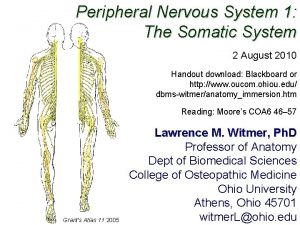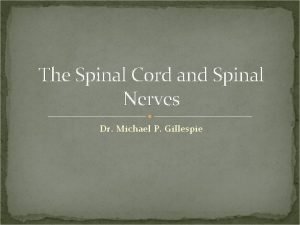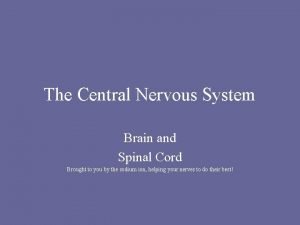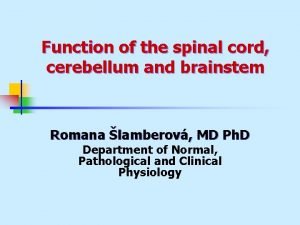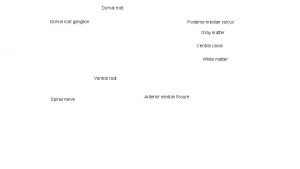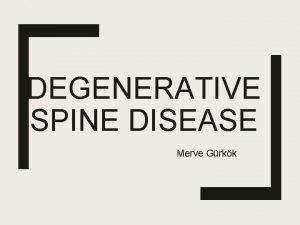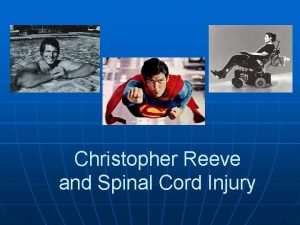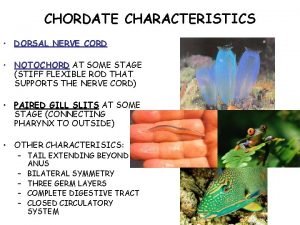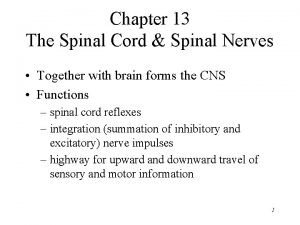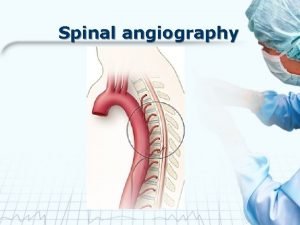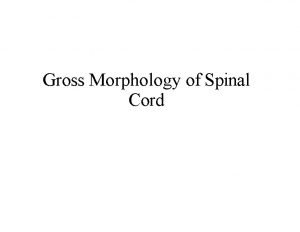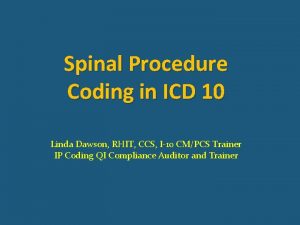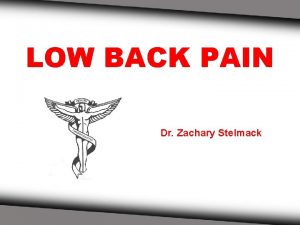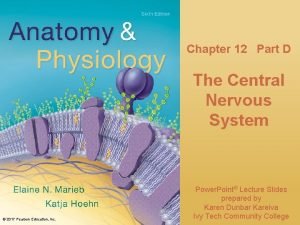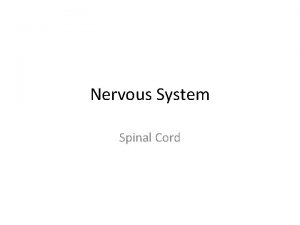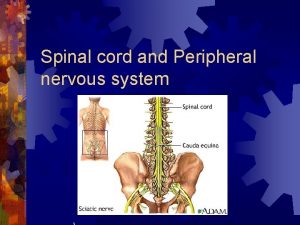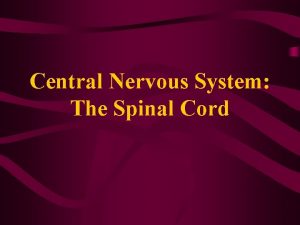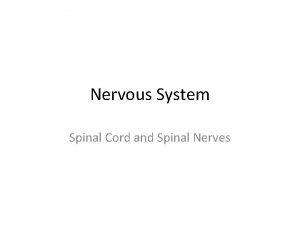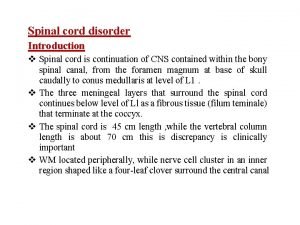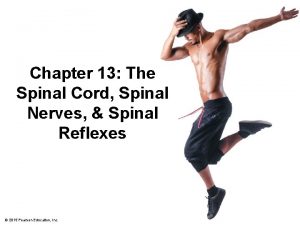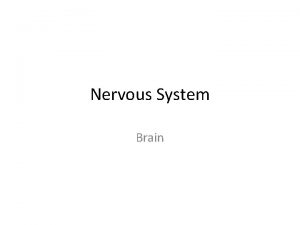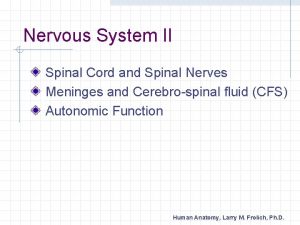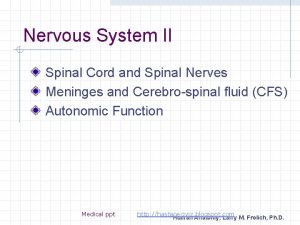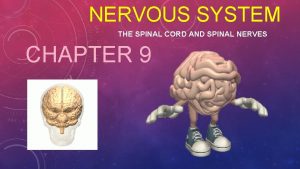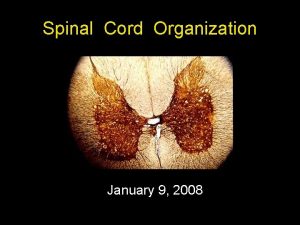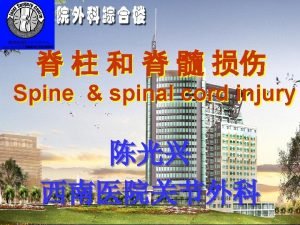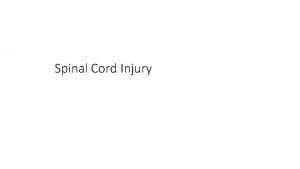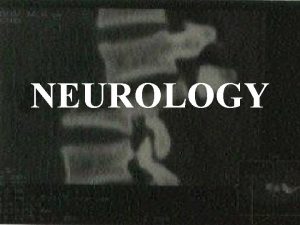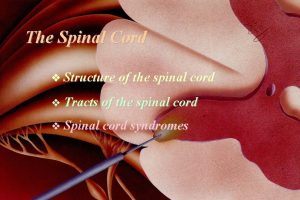Chapter 10 The Nervous System Introduction Spinal Cord


































- Slides: 34


Chapter 10 The Nervous System Introduction, Spinal Cord, and Spinal Nerves 2

Introduction • Control center and communication network – Directs functions of body’s organs and systems – Interprets external environment – Determines reaction to change 3

Introduction (cont’d. ) • Homeostasis: balanced internal environment – Controlled by nervous and endocrine systems 4

Organization 5

Organization (cont’d. ) • Central nervous system: brain and spinal cord • Peripheral nervous system – Afferent peripheral system • Sensory neurons – Efferent peripheral system • Somatic • Autonomic: sympathetic and parasympathetic 6

Organization (cont’d. ) 7

Classification of Nerve Cells 8

Neuroglia Cells • Astrocytes: support, connection, bloodbrain barrier • Oligodendroglia: support, myelin sheath formation • Microglial: phagocytosis • Ependymal: line the ventricles of the brain • Schwann: myelin sheaths in peripheral nervous system 9

The Structure of a Neuron • Cell body • Dendrites: receptive areas • Axon: extension of cell body – Schwann cells – Nodes of Ranvier 10

The Structure of a Neuron (cont’d. ) 11

The Structure of a Neuron (cont’d. ) • Multipolar: several dendrites coming off cell body • Bipolar: one dendrite and one axon • Unipolar: one process extending from cell body 12

The Structure of a Neuron (cont’d. ) • Receptors: detect environmental stimuli • Sensory: receive impulse from receptor site • Internuncial: transmit impulse for interpretation and processing • Motor: reaction to the stimulus 13

The Physiology of the Nerve Impulse 14

The Physiology of the Nerve Impulse (cont’d. ) • Nerve cell fiber resting potential – Na+ concentration higher on outside – K+ concentration higher on inside – Negative charge on inside – Positive charge on outside 15

The Physiology of the Nerve Impulse (cont’d. ) • Depolarization: Na+ rush inside cell • Repolarization: K+ rush out to restore balance • Depolarization: Repolarization moves in one direction • Myelinated vs. unmyelinated • All-or-none law 16

The Synaptic Transmission 17

The Synaptic Transmission (cont’d. ) • Synapse: axon terminal branches close to next dendrites • Impulse reaches axon terminals • Triggers neurotransmitter release into synaptic cleft 18

The Synaptic Transmission (cont’d. ) • Neurotransmitters – Acetylcholine • Most common – Epinephrine – Norepinephrine – Serotonin – Dopamine – Endorphins 19

The Synaptic Transmission (cont’d. ) 20

The Reflex Arc 21

The Reflex Arc (cont’d. ) • Knee-jerk reflex • Maintain homeostasis – Heartbeat/breathing rates – Digestion – Coughing – Sneezing – Swallowing – Vomiting 22

The Reflex Arc (cont’d. ) • Involuntary reaction to external stimulus 23

Grouping of Neural Tissue 24

Grouping of Neural Tissue (cont’d. ) • White matter – Groups of myelinated axons – Forms nerve tracts in CNS • Gray matter – Nerve cell bodies and dendrites – Unmyelinated axon bundles – Cortex: gray matter on surface of brain 25

Grouping of Neural Tissue (cont’d. ) • • Nerve: bundle of fibers outside CNS Ganglia: nerve cell bodies outside CNS Tract: bundle of fibers inside CNS Nucleus: nerve cell bodies and dendrites inside CNS • Horns: areas of gray matter in spinal cord 26

The Spinal Cord 27

Introduction • Continuation of medulla oblongata • 31 segments each with a pair of spinal nerves • Protected by meninges – Dura mater – Arachnoid – Pia mater 28

29 29

Functions of the Spinal Cord • Conveys sensory impulses to the brain • Integrates reflexes • Spinal nerves connect at roots – Dorsal root: sensory – Ventral root: motor 30

The Spinal Nerves 31

The Spinal Nerves (cont’d. ) • All 31 pairs arise from union of dorsal and ventral roots • Mixed nerves consisting of motor and sensory fibers • Most exit vertebral column between vertebrae 32

The Spinal Nerves (cont’d. ) • Named and numbered according to region and level of spinal cord – Cervical: 8 pairs – Thoracic: 12 pairs – Lumbar: 5 pairs – Sacral: 5 pairs – Coccygeal: 1 pair 33

Summary • Named the major division of the nervous system • Classified neurons and neuroglial cells • Discussed the physiology of the nerve impulse and transmission at synapses • Named the different types of neural tissue • Discussed the structure of the spinal cord • Named the spinal nerves 34
 Dermatome map
Dermatome map Spinal cord tracts labeled
Spinal cord tracts labeled Figure 13-2 spinal nerves labeled
Figure 13-2 spinal nerves labeled Exercise 15 spinal cord and spinal nerves
Exercise 15 spinal cord and spinal nerves Spinal cord and spinal nerves exercise 15
Spinal cord and spinal nerves exercise 15 Brain nervous system
Brain nervous system Which neuron is rare
Which neuron is rare Sensory input and motor output
Sensory input and motor output Nerve cell process
Nerve cell process Spinal cord denticulate ligament
Spinal cord denticulate ligament Nervous sysytem
Nervous sysytem Causes of spinal cord compression
Causes of spinal cord compression Spinal cord tumors
Spinal cord tumors Function of the pons
Function of the pons Posterior dorsal median sulcus
Posterior dorsal median sulcus Intervertebral disc prolapse
Intervertebral disc prolapse Christopher reeve spinal cord injury level
Christopher reeve spinal cord injury level Dorsal nerve cord vs notochord
Dorsal nerve cord vs notochord Components of the reflex arc
Components of the reflex arc Components of the reflex arc
Components of the reflex arc Spinal cord organization
Spinal cord organization Neural circuits the organization of neuronal pools
Neural circuits the organization of neuronal pools Osd sindrom
Osd sindrom 31 pairs of spinal nerves
31 pairs of spinal nerves Artery of adamkiewicz
Artery of adamkiewicz Stretch reflex
Stretch reflex Mezgovnice
Mezgovnice Spinal cord
Spinal cord Tissue
Tissue Spinal cord function
Spinal cord function Eat well live well with spinal cord injury
Eat well live well with spinal cord injury Thecal sac
Thecal sac Intensivis
Intensivis Low back rom
Low back rom Spinal cord cross section
Spinal cord cross section
